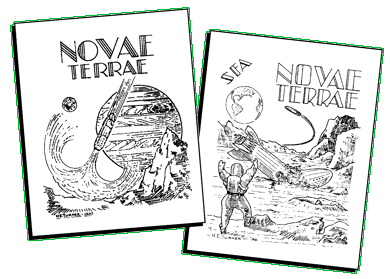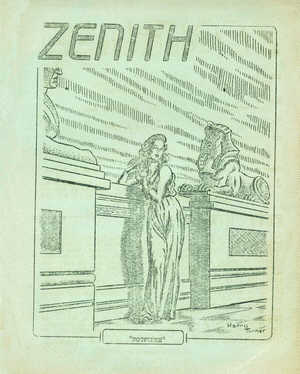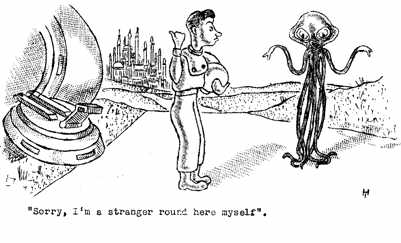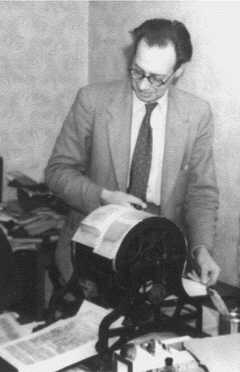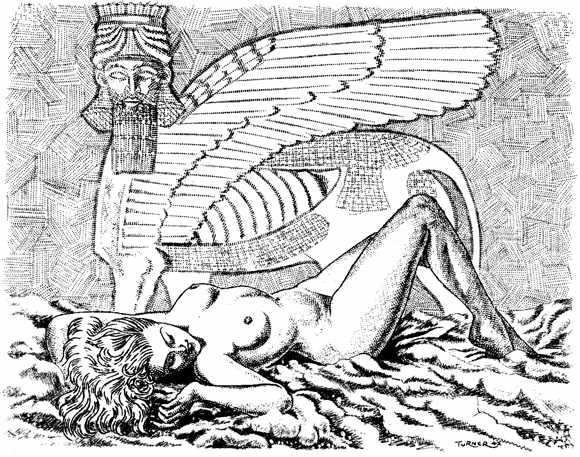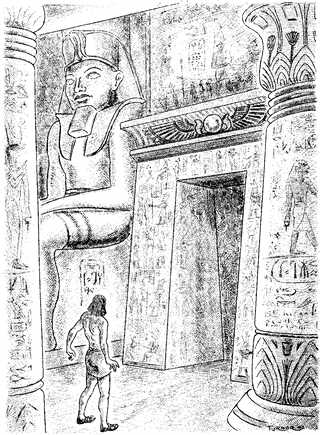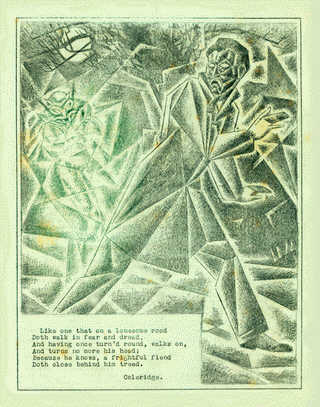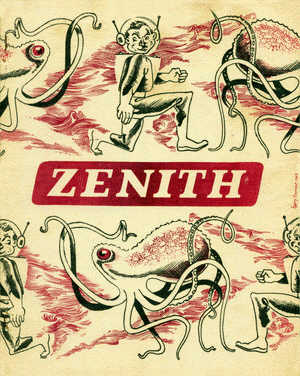
| Zenith – A Brief History | FOOTNOTES Page | Obituary Page | |
 |
“Send me more,
– Eric Frank Russell’s comment |
☺ ☺ ☺ ☺ ☺ ☺ On Pubbing My First Ish... The events I am about to describe took place over half a century ago, a period that bridges several fannish generations. So far as I can check the details are accurate, but I won’t vouch for everything. As Marcel Duchamp has said, “it is curious to note to what an extent memory is unfaithful, even for the most important periods of one’s life. That, indeed, explains the delightful fantasy of history.” Of course, he said it in French, but I guess it’s true in any language... ☺ ☺ ☺ ☺ ☺ ☺ I guess my prime urge in putting out Zenith during the early war years was the opportunity to do more illustration work. I'd acquired a certain expertise hand-cutting designs directly on to stencils since my first involvement with fan pubbing way back in 1937. That was when I began to do cover stencils for the Science Fiction Association monthly mag Novae Terrae, in the days when it was produced and edited by Maurice Hanson, with help from Bill Temple and Arthur Clarke, in London. I recall that Maurice provided me with a fiendishly sharp print trimmer to cut my first design on to stencil, and I had great difficulty in keeping the shreds hanging together in one piece for its return. Somehow or other, Maurice managed to duplicate it, but I promptly made myself some more efficient styluses, acquired wheel pens to create tint effects, and found out the hard way how to use them to best effect. I picked up tips from stencilled artwork in the many US fanzines that reached me, and was soon doing regular work for several of the early British mags – including Liverpool fan John Burke's Satellite, and The Fantast, first edited by Sam Youd in Eastleigh and later, when he was conscripted, taken over by Doug Webster in Aberdeen. Most British fanzines of the time offered pages of unrelieved typed text: I wanted to see more use of graphics, spurred on by the example of US editors making full use of aids such as lettering-guides, tint plates, photo-stencils... items that, alas, were difficult to come by in wartime Britain!
So much for ambitions. When I decided to produce Zenith in 1941 I was fortunate in my contacts: contributors included names still familiar to most fans today – Arthur C. Clarke, Bill Temple, John ‘Ted' Carnell, Sam Youd, Eric Frank Russell – and many yesteryear fans who deserve mention in any fannish chronicles – Doug Webster, D.R. Smith, John Burke, Maurice Hanson, Sid Birchby, Eric Hopkins, Don Doughty, John ‘Zeus' Craig, Edwin Macdonald, J.E. Rennison... they provided a stream of short stories, articles, poems and lively letters of comment. I had help from my wife-to-be, Marion Eadie (soon promoted to co-editor), who wrote several satirical pieces and stories, and typed many of the stencils – at the cost of much juggling of word spacing, Zenith boasted justified margins. And I had lots of fun experimenting and seeing what limits there were to doing artwork direct on to stencil.
The first issue of Zenith appeared in August 1941. I have a copy of one of the original issues in front of me now, with a contents page listing John F. Burke, Ted Carnell, Maurice K. Hanson, and C.S. Youd among the contributors. It was a year when British fanzines were becoming scarce as fans disappeared into the armed forces, and paper and duplicating materials increasingly difficult to lay hands on. I suppose my own venture into fanpubbing owed much to the enthusiasm of Mike Rosenblum, then issuing Futurian War Digest (popularly known as FIDO) to keep fanac alive during the early war years, following the winding up of the Science Fiction Association. Most actifans were involved in some way with FIDO, sending in letters and news, and occasional duplicated sheets or material that Mike and Doug Webster would print for them, often on paper donated by generous American fans. Mike periodically collated all the sheets that happened to be on hand and mailed them out to fans at home and in the forces. I recall sending in a few stencils of a proto-Zenith for inclusion in Mike’s mailings, but when I acquired a duplicator of my own and located a store of duplicating paper, I decided it was time I did my own thing. Describing this event at a later date, fellow-Mancunian fan Eric Needham remarked... “Fans old enough to remember when Zenith first appeared will recall that a war had broken out a few months before. Patriotic appeals were launched for scrap metal, and great dumps of rusty machinery appeared everywhere. I do not claim there is any connection... but this is the time that Harry acquired his 1913 Model 2a Roneo duplicator, a purely palaeotechnic device, lavish in its use of ornamental cast-iron, that qualifies for the title of being an upright grand.” While I wouldn’t swear as to the accuracy of Eric’s dating, but as he was an expert on things primitive and mechanical, I take it on trust. While in my possession (and it went on printing fanzines until the late fifties, which is perhaps a sort of record), the machine never worked as originally intended. The inking mechanism appeared to consist of a roller supposed to force ink through the perforated zinc drum, covered by several thicknesses of fabric, over which the stencil was placed. However, this roller proved immovable in operation, never making contact with the drum at any time. The method of inking recommended to me by the original owner (and looking back I suspect he must have been one of Von Däniken’s astronauts moulding the shape of fandom to come) was to slosh ink on to the blanket with a paintbrush before putting on the stencil. It required some practice to judge the correct amount of ink required: too liberal an application flooded the stencil, too sparing a dose gave patchy results. Persistence and experience eventually enabled me to assess all the variables involved – size of paintbrush, consistency of ink, room temperature, the height of the Heaviside layer – and the inking routine became automatic. On a good day, I could guarantee to print 20 to 25 sheets before having to lift the stencil and apply more ink. As the machine was not an automatic feeder, sheets of paper had to be carefully positioned for feeding individually. And for various reasons (like being a perfectionist) I used to slip-sheet. All this may strike contemporary fans as a slow and tedious way of producing a fanzine. It was. But this heap of junk had one great advantage over more sophisticated gear. It could do multi-colour printing in a single operation and in perfect register by exploiting the defects of the system. Because of the unorthodox method of inking, it was an easy matter to paint selected areas of the blanket with different coloured inks, so that when a sheet was run through it finished up with, say, a red heading, black text, and a green illustration. All in one go; in register every time. And it was so simple to do. The only thing that needed watching was to check that the colours did not spread and merge beyond the areas you wanted; but areas could be sharply defined when inking by outlining each colour when applying the black ink. (In later issues of Zenith, I realised that this effect of merging colours could be exploited in illustrations to create unusual effects not obtainable by the conventional means of several separate colour runs). Years later I was still being asked how it was done; the truth never seemed to convince questioners! There was an additional hazard to inking. This was a time of extreme economy – stencils were hard to come by (and so was money for that matter) and many fans, like myself, snipped off the lower unused portion of stencils and replaced it in operation with a piece of backing sheet, which kept the ink at bay long enough for the usual run of around 100 copies. The salvaged bits of stencil could be stuck together with gummed paper, Sellotape, and a lot of faith, to provide an extra page; the constant threat of disintegration when ever the stencil was lifted for reinking all added to the excitement I suppose. But enough of technical matters.
As the war dragged on, meetings at my home became sporadic as Manchester fans disappeared into the forces – I lost touch with some of the regulars – Stan Davis, Fred Tozer, Bill Shelton. My turn to register came early in December 1940; as call-up usually followed a month or so after, I hastily travelled up to Glasgow to spend Christmas with Marion. The over-night return journey home by rail seemed interminable. The train kept stopping at deserted stations – eventually a guard came round to tell us that Manchester had been blitzed for two nights running, and trains had to be rerouted, crawling round while emergency services tried to restore some order in the smoking city. We eventually got off the train, to find there were no trams or buses running. I walked home through chaos, past a damaged barracks and the still-smoking ruins of the Ardwick cinema, and finally scrambled round several bomb craters close to home, relieved to find the house still standing and my parents shattered by the experience... Come the end of January, I had a note informing me that records had been destroyed in the blitz and enclosing new forms for me to complete. After this temporary reprieve I steeled myself for a prompt call-up. During February, Arthur Clarke, at Colwyn Bay expecting his call-up papers, started to circulate a chain-letter, FAN MAIL, (and when Marion and I decided to become engaged it made front-page news in an early issue). When Arthur went into the RAF in April, Sam Youd continued to circulate the chain-letter. The weeks passed and I was surprised to still be clinging on to my civilian status. Then I was requested to fill in another set of forms following heavy air raids in May (I began to suspect a German plot to keep me out of the forces) in July. After which, Marion decided to come down to work in Manchester. Eric Needham reported to the RAF in August 41. I was surprised at lingering on, until I had a note advising that records had been destroyed in the Xmas blitz on Manchester in 1940... and I'd have to re-register. A long wait followed, and then a further note to say records had been destroyed in another blitz... Began to think that Hitler was going to extraordinary lengths to prevent me joining in the fray. I fancy Zenith was the first British fanzine to offer nudes as a regular feature. I had a bulging portfolio of sketches made at life classes in the studio of Manchester artist John Bold, so it was inevitable that some of the results were translated on to stencil and appeared in zenith. They were among the items provoking the most comments, ranging from Doug Webster’s “now there’s a lissome wench” to Eric Frank Russell's response to the cover of the second issue: "Ah, she beautiful, she ravishing! I kees er – vat you call heem? – er bottum! Send me more, with extra bottums", to Bill Temple's complaint in a later issue: "You are doing an unkind and thoughtless thing ... in continually sending these nudes to an impression-able, sex-starved soldier, and may have to answer for the consequences".
As I recall, Forry Ackerman was then featuring VoMaidens in the Los Angeles SF Club fanzine Voice of the Imagination...He was impressed by Study in Zenith #4 and wrote asking me to contribute to his series, and mailed several stencils – state-of-the-art blue nylon films which were a delight to work on after the ageing relics available here. So Study 2 was diverted to 4SJ, to bring the encouraging response: "The stencilovely ... Just wait'll we get our ink on her. I scarcely can wait to roll her into the bed! (Hey, I'm talking about cranking copys into the mimeo container, of corse... don't get me rong!). Vomaiden Portfolios have been discontinued til the spirit inspires me again but your grand fantasyren will be featured in the next (#23) VOM." (I was reminded of this wartime exchange when more than fifty years later, Art Widner was moved to repro the VOM pic in his zine Yhos #54, with a few kind words of praise).
Five issues [of Zenith] were published between August 1941 and April 1942. A sixth issue was prepared and almost ready for production when Fate intervened. The RAF sent me my call-up papers, with impeccable timing, just as Marion and I decided to get wed. In the subsequent confusion, Zenith #6 languished on stencil for several months. Somehow, on the odd occasions when I managed to dash back home for a weekend with Marion we never seemed to find time for fanac. When up-and-coming Manchester fan Ron Lane started his own fanzine, I accepted the inevitable and, to help out, passed over the material planned for Zenith.
Years later, in 1953, there was an ill-fated attempt at revival when Derek Pickles talked me into trying again. By this time I had access to a Multilith machine, was able to indulge in printing offset litho, with hand-drawn plates and multicolour; all the facilities were there but the support was not forthcoming. And I guess my ideas had changed in the intervening years, drastically, and the project foundered. Even more years later, in 1973, I was persuaded, after a period of gafiation, to return to the fold at the Bristolcon. It seemed that a file of Zenith had become a collector’s piece: there in a dealer’s catalogue I read: “Zenith (Ed by Harry Turner) numbers 1 - 5 (8/41; 10/41; 12/41; 2/42; 4/42). VG condition. Edited by a leading artist for the prewar British SF magazines. Zenith is an early example of the often beautiful effects an artist can achieve in one or more colours with only the mimeograph stencil as a ‘canvas’ (before the days of electronic aids). These five issues include much artwork by Turner, including full-page illustrations inspired by Coleridge and Poe, a poem and an SF short story ‘Impetus’ by C.S. Youd (John Christopher) and an Arthur C. Clarke short SF story ‘The Awakening’. £12.50 / $30.00" It seemed that a file of wartime zeniths had become a collector's item: I kicked myself for not hanging on to several complete runs of the mag as an investment for my old age (like now). Zenith was sent out for free to anyone interested – and it reached American and Aussie fandom as well as home fandom despite wartime upsets – with a nominal price for anyone so foolish as to insist on paying: but I don't recall anyone ever was. ☺ ☺ ☺ ☺ ☺ ☺
|
 |
